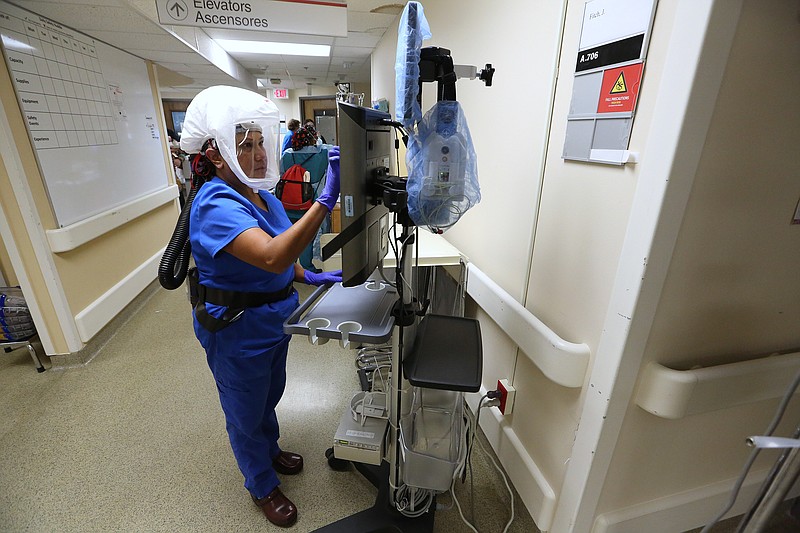The number of people hospitalized with covid-19 in Arkansas rose Thursday for the fifth day in a row as the state's cumulative count of cases since March 2020 topped 900,000.
The state's death toll from the virus, as tracked by the Department of Health, rose by 10, to 11,699.
State Epidemiologist Mike Cima said six of the deaths reported Thursday happened within the past month.
Of the others, one occurred in January, one was from February, one was from March and one was from earlier in June.
The number hospitalized rose by 14, to 435, remaining just short of the recent high of 442 that it reached just over a week earlier.
The state's count of cases rose by 1,578, to 901,129, surpassing 900,000 less than six months after it topped 800,000.
Some Arkansans are counted more than once in the official total.
As of Monday, for instance, 44,663 of the state's cases represented infections of people who had already been infected -- and included in the official case count -- at least once before, Health Department spokeswoman Danyelle McNeill said.
On the other hand, Cima said, the actual number of Arkansans who have been infected since the start of the pandemic is "probably way higher" than 900,000 since not everyone who is infected gets tested, and the results of at-home tests aren't typically reported to the Health Department.
Based on a study of antibodies found in blood samples drawn for routine medical screenings, the U.S. Centers for Disease Control and Prevention estimated that about 64% of Arkansans, including 81.3% of Arkansas children, had been infected with covid-19 by late February.
Of the cases in Arkansas' official count, more than a third have been added this year, including more than 220,000 that were recorded in January, during the state's initial surge of infections from the omicron variant.
After the peak of that surge, the state's new case numbers declined rapidly, reaching a low plateau before they began slowly climbing in late April.
Cima said the state's latest wave of infections, fueled by even more infectious versions of omicron but much less severe than the winter surge, appears to have peaked.
When new cases are examined by the date of symptom onset or date of the test result, rather than when the result was reported, "We see a pretty distinct trend downward," he said.
"I think we're on the back side of this surge. I'm getting more confident of that," Cima said.
Much like the gradual uptick that characterized the start of the wave, however, the decline so far as been slow.
The increase over the past few days in the number hospitalized, Cima said, "speaks to the fact that there are still a lot of cases out there."
Because it can take several days for someone to become sick enough to be hospitalized, he said, the number in hospitals "may continue to fluctuate to some degree over the next couple of days even if cases continue to decrease."
ACTIVE CASES RISE
The statewide increase in the case count on Thursday was smaller by more than 200 than the one a day earlier but larger by 52 than the one the previous Thursday.
After falling the previous five days, the average daily increase in the state's case count over a rolling seven-day period rose Thursday to 1,237.
That was down from an average of more than 1,300 a day the previous week, however, and a recent high of 1,506 a day the week ending July 12.
Similarly, the number of cases in the state that were considered active rose by 237, to 16,015, as new cases outpaced recoveries, but remained down from a recent high of 16,946 that the total reached on July 20.
Rising for the second day in a row, however, the numbers of the state's virus patients who were in intensive care and on ventilators both reached their highest levels in months.
The number in intensive care rose by nine, to 88, its highest level since March 12.
The number on ventilators grew by two, to 22, the largest number since April 7.
Pulaski County had the most new cases, 251, on Thursday, followed by Washington County with 106, Faulkner County with 70 and Benton County with 69.
At its hospitals in Little Rock and Springdale, Arkansas Children's had 17 covid-19 patients on Thursday, up from 11 a week earlier, spokeswoman Hilary DeMillo said.
Also on Thursday, decreases in metrics related to new cases, hospitalizations, or both led to the number of Arkansas counties where the CDC recommends that people wear masks in indoor public places falling from 49 to 42.
The recommendation applies to counties where the "covid-19 community level," based on the weekly number of new cases, hospital admissions for covid-19 and the percentage of staffed hospital beds that are occupied by covid-19 patients, is considered "high."
Under the latest update to a CDC map, the covid-19 level went from high to "medium" in Ashley, Cleveland, Fulton, Hot Spring, Montgomery, Phillips, Stone and Yell counties and from high to "low" in Chicot County.
In Logan and Ouachita counties, meanwhile, the level rose from medium to high.
Overall, the number of counties with a medium covid-19 level rose by six, to 27. The number with a low level rose by one, to six.
Among the state's most populous counties, the level remained high in Pulaski, Sebastian, Faulkner, Saline and Craighead counties, low in Benton County and medium in Washington County.
In counties with a medium covid-19 level, the CDC recommends people who are immunocompromised or at high risk of severe covid-19 talk to their health care providers about whether they should wear masks or take other precautions.
People in those counties also should consider wearing masks around people who have a high risk of severe illness, according to the CDC.
In counties with low covid-19 levels, the CDC doesn't have a recommendation about whether people should wear masks.
